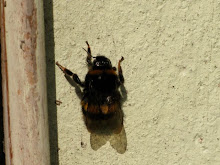 A weeks ago I attended a meeting at our divisional apiary. It occupies a large green space amid an urban residential area which is ideal for bees. At the mreting novice beekeepers were told it's time to prepare our bees for winter. Looking at the warm sunny afternoon it was hard to believe that my first beekeeping season is already ending . We were advised to treat our hives for varroas, and to start feeding the hive.
A weeks ago I attended a meeting at our divisional apiary. It occupies a large green space amid an urban residential area which is ideal for bees. At the mreting novice beekeepers were told it's time to prepare our bees for winter. Looking at the warm sunny afternoon it was hard to believe that my first beekeeping season is already ending . We were advised to treat our hives for varroas, and to start feeding the hive.Prior to the meeting I inspected my hive and decided to remove the super, which the bees had hardly touched since I installed it a month ago. As I didn't get my nuc till mid June I am assuming that the colony is too busy building itself up to strength to start on the super. In spite of the empty super I could see that the brood box is in good shape. There are many sealed cells and honey store which means that the queen is laying, and the worker bees had been working hard collecting. It's difficult to judge how much the colony had grown over the last two and half months. I estimated it has double in size, which means that it now numbers at around 8 to 10 thousand bees. I saw no drones throughout this inpection which is yet another sign of the season coming to an end. My son (photo) helped me to remove the frames from the super. Where previously he was only allow to watch this time he had a great time getting to do something with the hive.
Followed the meeting at the apiary I immediately made up a sugar solution for the bees. Yesterday I checked and saw the feed has all but gone, so I mad up another feed. When I poured the solution into the feeder I noted the bees are much less active. Yes, autumn is here.

